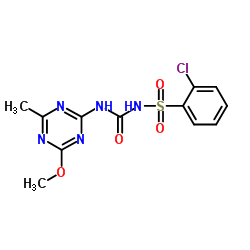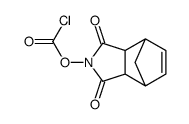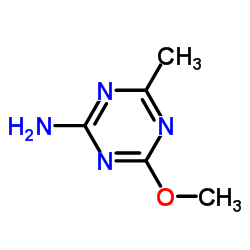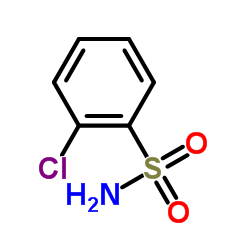64902-72-3
| 中文名 | 氯磺隆 |
|---|---|
| 英文名 | chlorsulfuron |
| 中文别名 |
绿黄隆
绿磺隆 绿黄隆,1-(2-氯苯基磺酰)3-(4-甲氧基-6-甲基-1,3,5-三嗪-2-基)脲 嗪磺隆 1-(2-氯苯基磺酰)-3-(4- 甲氧基-6-甲基-1,3,5-三嗪-2-基)脲 |
| 英文别名 |
2-Chloro-N-[(4-methoxy-6-methyl-1,3,5-triazin-2-yl)carbamoyl]benzenesulfonamide
Chlorsulfuron GLEAN Benzenesulfonamide, 2-chloro-N-[[(4-methoxy-6-methyl-1,3,5-triazin-2-yl)amino]carbonyl]- 2-Chloro-N-[[(4-methoxy-6-methyl-1,3,5-triazin-2-yl)amino]carbonyl]benzenesulfonamide Clean T6N CN ENJ BO1 DMVMSWR BG& F1 TELAR onamide finesse PRESS MFCD00128059 EINECS 265-268-5 1-(2-chlorophenylsulfonyl)-3-(4-methoxy-6-methyl-1,3,5-triazin-2-yl)urea gleanc ALMURON 2-chloro-N-[(4-methoxy-6-methyl-1,3,5-triazin-2-yl)carbamoyl]benzene-1-sulfonamide W-4189 LASHER chlorsulfuron [ANSI] |
| 描述 | Chlorsulfuron 可阻断植物体内氨基酸缬氨酸和异亮氨酸的生物合成。Chlorsulfuron 可完全缓解除草剂诱导的生长抑制。Chlorsulfuron 的作用位点是乙酰酸合酶。 |
|---|---|
| 相关类别 | |
| 参考文献 |
| 密度 | 1.5±0.1 g/cm3 |
|---|---|
| 沸点 | 563ºC |
| 熔点 | 174-178°C |
| 分子式 | C12H12ClN5O4S |
| 分子量 | 357.773 |
| 精确质量 | 357.029846 |
| PSA | 131.55000 |
| LogP | 2.14 |
| 外观性状 | 无色晶体 |
| 折射率 | 1.617 |
| 储存条件 | 存放在密封容器内,并放在阴凉,干燥处。 |
| 稳定性 | 远离氧化物。对眼睛有轻微刺激,对皮肤无刺激。动物试验未见致畸、致癌、致突变作用。 |
| 分子结构 | 1、 摩尔折射率:81.54 2、 摩尔体积(cm3/mol):232.8 3、 等张比容(90.2K):679.5 4、 表面张力(dyne/cm):72.4 5、 极化率(10-24cm3):32.32 |
| 计算化学 | 1.疏水参数计算参考值(XlogP):2.3 2.氢键供体数量:2 3.氢键受体数量:7 4.可旋转化学键数量:4 5.互变异构体数量:9 6.拓扑分子极性表面积132 7.重原子数量:23 8.表面电荷:0 9.复杂度:514 10.同位素原子数量:0 11.确定原子立构中心数量:0 12.不确定原子立构中心数量:0 13.确定化学键立构中心数量:0 14.不确定化学键立构中心数量:0 15.共价键单元数量:1 |
| 更多 | 1. 性状:无色结晶。 2. 密度(g/mL,25/4℃):未确定 3. 相对蒸汽密度(g/mL,空气=1):未确定 4. 熔点(ºC):186-188 5. 沸点(ºC,常压):563 6. 沸点(ºC,5.2kPa):未确定 7. 折射率:未确定 8. 闪点(ºC):未确定 9. 比旋光度(º):未确定 10. 自燃点或引燃温度(ºC):未确定 11. 蒸气压(kPa,25ºC):6.133×10-4 12. 饱和蒸气压(kPa,60ºC):未确定 13. 燃烧热(KJ/mol):未确定 14. 临界温度(ºC):未确定 15. 临界压力(KPa):未确定 16. 油水(辛醇/水)分配系数的对数值:2.63 17. 爆炸上限(%,V/V):未确定 18. 爆炸下限(%,V/V):未确定 19. 溶解性:未确定。 |
|
Section1. IDENTIFICATION OF THE SUBSTANCE/MIXTURE Product identifiers Product name: Chlorosulfuron CAS-No.: 64902-72-3 Relevant identified uses of the substance or mixture and uses advised against Identified uses: Laboratory chemicals, Manufacture of substances Section2. HAZARDS IDENTIFICATION Classification of the substance or mixture Classification according to Regulation (EC) No 1272/2008 [EU-GHS/CLP] Acute aquatic toxicity (Category 1) Chronic aquatic toxicity (Category 1) Classification according to EU Directives 67/548/EEC or 1999/45/EC Very toxic to aquatic organisms, may cause long-term adverse effects in the aquatic environment. Label elements Labelling according Regulation (EC) No 1272/2008 [CLP] Pictogram Signal wordWarning Hazard statement(s) H410Very toxic to aquatic life with long lasting effects. Precautionary statement(s) P273Avoid release to the environment. P501Dispose of contents/ container to an approved waste disposal plant. Supplemental Hazardnone Statements According to European Directive 67/548/EEC as amended. Hazard symbol(s) R-phrase(s) R50/53Very toxic to aquatic organisms, may cause long-term adverse effects in the aquatic environment. S-phrase(s) S60This material and its container must be disposed of as hazardous waste. S61Avoid release to the environment. Refer to special instructions/ Safety data sheets. Other hazards - none Section3. COMPOSITION/INFORMATION ON INGREDIENTS Substances Formula: C12H12ClN5O4S Molecular Weight: 357,77 g/mol ComponentConcentration Chlorsulfuron CAS-No.64902-72-3- EC-No.265-268-5 Index-No.613-121-00-4 Section4. FIRST AID MEASURES Description of first aid measures General advice Consult a physician. Show this safety data sheet to the doctor in attendance. If inhaled If breathed in, move person into fresh air. If not breathing, give artificial respiration. Consult a physician. In case of skin contact Wash off with soap and plenty of water. Consult a physician. In case of eye contact Flush eyes with water as a precaution. If swallowed Never give anything by mouth to an unconscious person. Rinse mouth with water. Consult a physician. Most important symptoms and effects, both acute and delayed Indication of any immediate medical attention and special treatment needed no data available Section5. FIREFIGHTING MEASURES Extinguishing media Suitable extinguishing media Use water spray, alcohol-resistant foam, dry chemical or carbon dioxide. Special hazards arising from the substance or mixture Carbon oxides, nitrogen oxides (NOx), Sulphur oxides, Hydrogen chloride gas Advice for firefighters Wear self contained breathing apparatus for fire fighting if necessary. Further information no data available Section6. ACCIDENTAL RELEASE MEASURES Personal precautions, protective equipment and emergency procedures Use personal protective equipment. Avoid dust formation. Avoid breathing vapors, mist or gas. Ensure adequate ventilation. Evacuate personnel to safe areas. Avoid breathing dust. Environmental precautions Prevent further leakage or spillage if safe to do so. Do not let product enter drains. Discharge into the environment must be avoided. Methods and materials for containment and cleaning up Pick up and arrange disposal without creating dust. Sweep up and shovel. Keep in suitable, closed containers for disposal. Reference to other sections For disposal see section 13. Section7. HANDLING AND STORAGE Precautions for safe handling Provide appropriate exhaust ventilation at places where dust is formed. Conditions for safe storage, including any incompatibilities Store in cool place. Keep container tightly closed in a dry and well-ventilated place. Specific end uses no data available Section8. EXPOSURE CONTROLS/PERSONAL PROTECTION Control parameters Components with workplace control parameters Exposure controls Appropriate engineering controls Handle in accordance with good industrial hygiene and safety practice. Wash hands before breaks and at the end of workday. Personal protective equipment Eye/face protection Use equipment for eye protection tested and approved under appropriate government standards such as NIOSH (US) or EN 166(EU). Skin protection Handle with gloves. Gloves must be inspected prior to use. Use proper glove removal technique (without touching glove's outer surface) to avoid skin contact with this product. Dispose of contaminated gloves after use in accordance with applicable laws and good laboratory practices. Wash and dry hands. The selected protective gloves have to satisfy the specifications of EU Directive 89/686/EEC and the standard EN 374 derived from it. Body Protection Choose body protection in relation to its type, to the concentration and amount of dangerous substances, and to the specific work-place., The type of protective equipment must be selected according to the concentration and amount of the dangerous substance at the specific workplace. Respiratory protection Respiratory protection is not required. Where protection from nuisance levels of dusts are desired, use type N95 (US) or type P1 (EN 143) dust masks. Use respirators and components tested and approved under appropriate government standards such as NIOSH (US) or CEN (EU). Section9. PHYSICAL AND CHEMICAL PROPERTIES Information on basic physical and chemical properties a) AppearanceForm: solid b) Odourno data available c) Odour Thresholdno data available d) pHno data available e) Melting point/freezingno data available point f) Initial boiling point and no data available boiling range g) Flash pointno data available h) Evaporation rateno data available i) Flammability (solid, gas) no data available j) Upper/lowerno data available flammability or explosive limits k) Vapour pressureno data available l) Vapour densityno data available m) Relative densityno data available n) Water solubilityno data available o) Partition coefficient: n- no data available octanol/water p) Autoignitionno data available temperature q) Decompositionno data available temperature r) Viscosityno data available s) Explosive propertiesno data available t) Oxidizing propertiesno data available Other safety information no data available Section10. STABILITY AND REACTIVITY Reactivity no data available Chemical stability no data available Possibility of hazardous reactions no data available Conditions to avoid no data available Incompatible materials no data available Hazardous decomposition products Other decomposition products - no data available Section11. TOXICOLOGICAL INFORMATION Information on toxicological effects Acute toxicity LD50 Oral - rat - 5.545 mg/kg LC50 Inhalation - rat - 4 h - > 5.900 mg/m3 LD50 Dermal - rabbit - 3.400 mg/kg Skin corrosion/irritation no data available Serious eye damage/eye irritation no data available Respiratory or skin sensitization no data available Germ cell mutagenicity no data available Carcinogenicity IARC:No component of this product present at levels greater than or equal to 0.1% is identified as probable, possible or confirmed human carcinogen by IARC. Reproductive toxicity no data available Specific target organ toxicity - single exposure no data available Specific target organ toxicity - repeated exposure no data available Aspiration hazard no data available Potential health effects InhalationMay be harmful if inhaled. May cause respiratory tract irritation. IngestionMay be harmful if swallowed. SkinMay be harmful if absorbed through skin. May cause skin irritation. EyesMay cause eye irritation. Additional Information RTECS: YS6640000 Section12. ECOLOGICAL INFORMATION Toxicity Toxicity to fishLC50 - Oncorhynchus mykiss (rainbow trout) - > 0,25 mg/l - 96,0 h Toxicity to daphnia and EC50 - Daphnia magna (Water flea) - 0,37 mg/l - 48 h other aquatic invertebrates Toxicity to algaeEC50 - Pseudokirchneriella subcapitata (green algae) - 0,13 mg/l - 96 h Growth inhibition LOEC - Pseudokirchneriella subcapitata - 0,019 mg/l - 96 h Persistence and degradability no data available Bioaccumulative potential no data available Mobility in soil no data available Results of PBT and vPvB assessment no data available Other adverse effects Very toxic to aquatic life. Section13. DISPOSAL CONSIDERATIONS Waste treatment methods Product Offer surplus and non-recyclable solutions to a licensed disposal company. Dissolve or mix the material with a combustible solvent and burn in a chemical incinerator equipped with an afterburner and scrubber. Contaminated packaging Dispose of as unused product. Section14. TRANSPORT INFORMATION UN number ADR/RID: 3077IMDG: 3077IATA: 3077 UN proper shipping name ADR/RID: ENVIRONMENTALLY HAZARDOUS SUBSTANCE, SOLID, N.O.S. (Chlorsulfuron) IMDG: ENVIRONMENTALLY HAZARDOUS SUBSTANCE, SOLID, N.O.S. (Chlorsulfuron) IATA:Environmentally hazardous substance, solid, n.o.s. (Chlorsulfuron) Transport hazard class(es) ADR/RID: 9IMDG: 9IATA: 9 Packaging group ADR/RID: IIIIMDG: IIIIATA: III Environmental hazards ADR/RID: yesIMDG Marine pollutant: yesIATA: yes Special precautions for user Further information EHS-Mark required (ADR 2.2.9.1.10, IMDG code 2.10.3) for single packagings and combination packagings containing inner packagings with Dangerous Goods > 5L for liquids or > 5kg for solids. Section15. REGULATORY INFORMATION This safety datasheet complies with the requirements of Regulation (EC) No. 1907/2006. Safety, health and environmental regulations/legislation specific for the substance or mixture no data available Chemical Safety Assessment no data available Section16. OTHER INFORMATION Further information Copyright 2012 Co. LLC. License granted to make unlimited paper copies for internal use only. The above information is believed to be correct but does not purport to be all inclusive and shall be used only as a guide. The information in this document is based on the present state of our knowledge and is applicable to the product with regard to appropriate safety precautions. It does not represent any guarantee of the properties of the product. Corporation and its Affiliates shall not be held liable for any damage resulting from handling or from contact with the above product. See and/or the reverse side of invoice or packing slip for additional terms and conditions of sale. |
|
毒理学数据: 1、急性毒性:大鼠(口服)LD50: 5,545mg/kg 大鼠(吸入)LC50: >5,900 mg/m3/4H 狗(口服)LD:>2,500 mg/kg 兔子(皮上)LD50:3,400mg/kg 鸭子(未报到)LD50:5 mg/kg 鸟(未报到)LD50:5 mg/kg 由于食盐的LD50是3,000 mg/kg,BPA的急性毒性程度与食盐同。 生态学数据: 通常对水是不危害的,若无政府许可,勿将材料排入周围环境。 CHEMICAL IDENTIFICATION
HEALTH HAZARD DATAACUTE TOXICITY DATA
|
| 符号 |

GHS09 |
|---|---|
| 信号词 | Warning |
| 危害声明 | H410 |
| 警示性声明 | P273-P501 |
| 个人防护装备 | Eyeshields;Gloves |
| 危害码 (欧洲) | N: Dangerous for the environment; |
| 风险声明 (欧洲) | R50/53 |
| 安全声明 (欧洲) | S60-S61 |
| 危险品运输编码 | UN3077 9/PG 3 |
| RTECS号 | YS6640000 |
| 海关编码 | 2935009011 |
|
~% 
64902-72-3 |
| 文献:Pharmazie, , vol. 44, # 3 p. 225 - 226 |
| 上游产品 2 | |
|---|---|
| 下游产品 1 | |
| 海关编码 | 2935009011 |
|---|---|
| 中文概述 | 2935009011 氟唑磺隆,氟吡磺隆,磺酰磺隆,氯酯磺草胺等〔包括甲酰胺嘧磺隆,乙氧磺隆,氯磺隆,甲磺隆,苯磺隆,胺苯磺隆〕。监管条件:S(进出口农药登记证明)。增值税率:17.0%。退税率:9.0%。最低关税:6.5%。普通关税:35.0% |
| 申报要素 | 品名, 成分含量, 用途 |
| 监管条件 | S.进出口农药登记证明 |
| Summary | 2935009011 2-chloro-n-((4-methoxy-6-methyl-1,3,5-triazin-2-yl)carbamoyl)benzenesulfonamide。supervision conditions:s(import or export registration certificate for pesticides)。VAT:17.0%。tax rebate rate:9.0%。MFN tarrif:6.5%。general tariff:35.0% |





